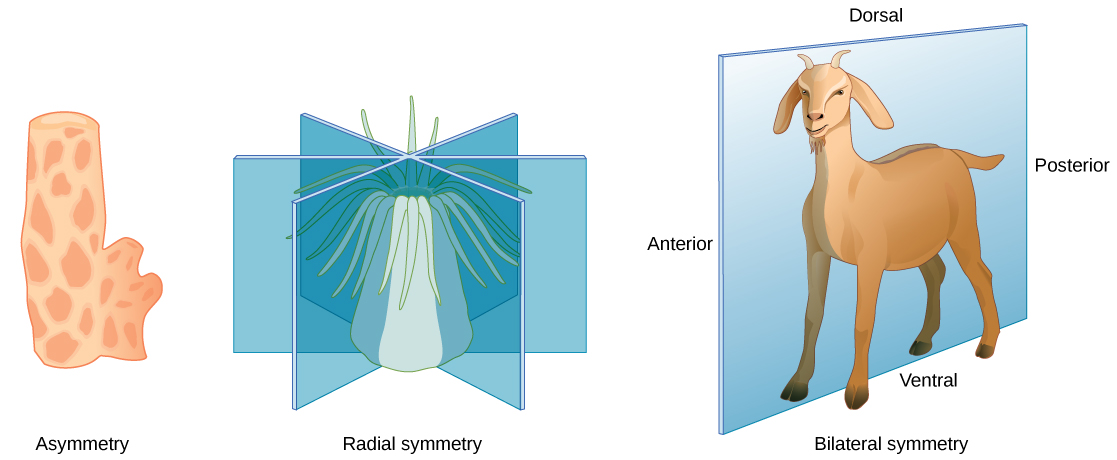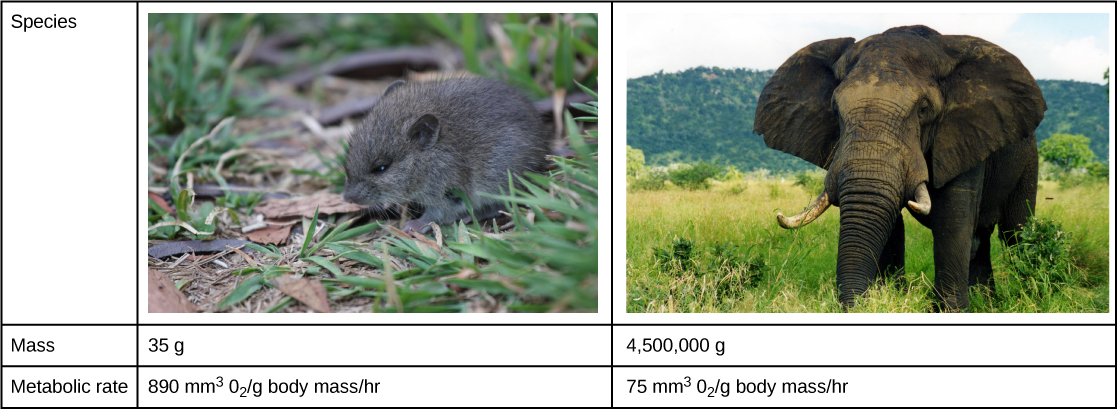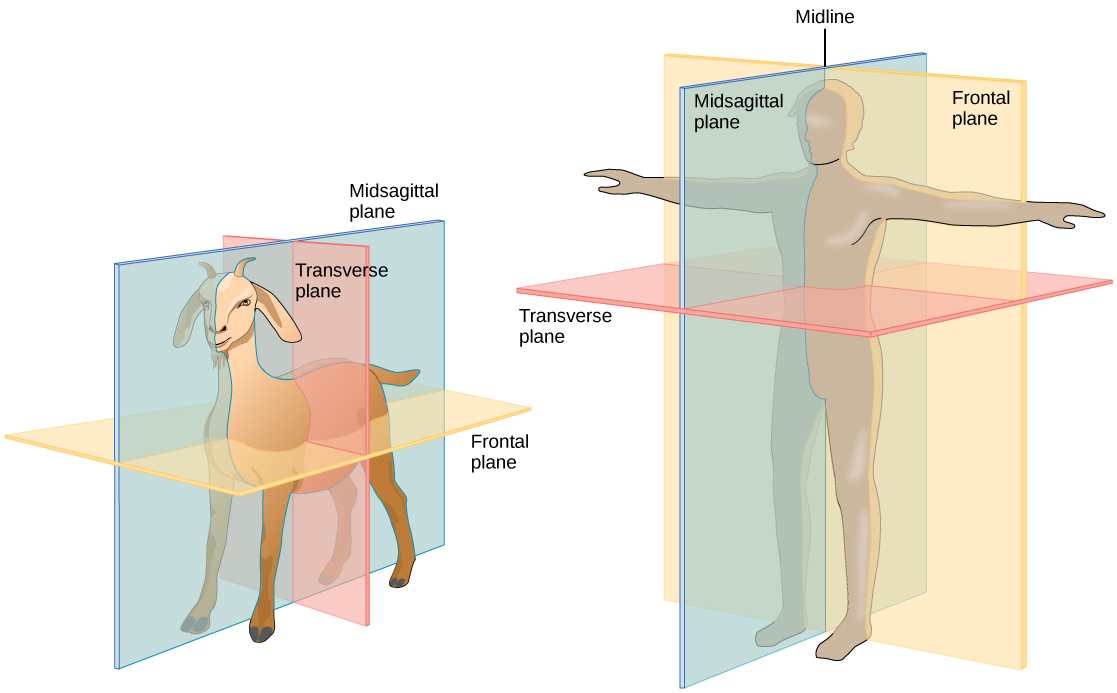33.1: Fomu ya wanyama na Kazi
- Page ID
- 175797
Ujuzi wa Kuendeleza
- Eleza aina mbalimbali za mipango ya mwili ambayo hutokea kwa wanyama
- Eleza mipaka juu ya ukubwa wa wanyama na sura
- Kuhusiana bioenergetics na ukubwa wa mwili, ngazi ya shughuli, na mazingira
Wanyama hutofautiana katika fomu na kazi. Kutoka sifongo hadi mdudu hadi mbuzi, kiumbe kina mpango tofauti wa mwili unaopunguza ukubwa na sura yake. Miili ya wanyama pia imeundwa ili kuingiliana na mazingira yao, iwe katika bahari ya kina, mto wa msitu wa mvua, au jangwa. Kwa hiyo, kiasi kikubwa cha habari kuhusu muundo wa mwili wa viumbe (anatomy) na kazi ya seli zake, tishu na viungo (physiolojia) zinaweza kujifunza kwa kujifunza mazingira ya viumbe.
Mipango ya Mwili
Mipango ya mwili wa wanyama hufuata ruwaza zilizowekwa zinazohusiana na ulinganifu. Wao ni asymmetrical, radial, au nchi mbili katika fomu kama inavyoonekana katika Kielelezo\(\PageIndex{1}\). Wanyama asymmetrika ni wanyama wasio na muundo wala ulinganifu; mfano wa mnyama asymmetria ni sifongo. Ulinganifu wa radial, kama ilivyoonyeshwa kwenye Kielelezo\(\PageIndex{1}\), inaelezea wakati mnyama ana mwelekeo wa juu-na-chini: ndege yoyote iliyokatwa pamoja na mhimili wake wa longitudinal kupitia viumbe hutoa nusu sawa, lakini si upande wa kulia au wa kushoto. Mpango huu unapatikana hasa katika wanyama wa majini, hasa viumbe vinavyojiunga na msingi, kama mwamba au mashua, na kutoa chakula chao kutoka maji ya jirani wakati unavyozunguka viumbe. Ulinganifu wa nchi mbili unaonyeshwa katika takwimu sawa na mbuzi. Mbuzi pia ana sehemu ya juu na ya chini yake, lakini ndege iliyokatwa kutoka mbele hadi nyuma hutenganisha mnyama kuwa pande za kulia na za kushoto za uhakika. Maneno ya ziada yanayotumiwa wakati wa kuelezea nafasi katika mwili ni anterior (mbele), posterior (nyuma), dorsal (kuelekea nyuma), na tumbo (kuelekea tumbo). Ulinganifu wa nchi mbili hupatikana katika wanyama wote wenye makao ya ardhi na majini; huwezesha kiwango cha juu cha uhamaji.

Mipaka juu ya ukubwa wa wanyama na sura
Wanyama wenye ulinganifu wa nchi mbili wanaoishi majini huwa na umbo la fusiform: huu ni mwili wenye umbo la tubular ambao umetiwa tapered katika ncha zote mbili. Umbo hili hupungua drag mwilini kama inapita kupitia maji na inaruhusu mnyama kuogelea kwa kasi ya juu. Jedwali hapa chini linaorodhesha kasi ya juu ya wanyama mbalimbali. Aina fulani za papa zinaweza kuogelea kwa kilomita hamsini kwa saa na baadhi ya pomboo kwa kilomita 32 hadi 40 kwa saa. Wanyama wa ardhi mara nyingi husafiri kwa kasi, ingawa kobe na konokono ni polepole sana kuliko duma. Tofauti nyingine katika marekebisho ya viumbe vya majini na makao ya ardhi ni kwamba viumbe wa majini huzuiwa kwa umbo na vikosi vya drag ndani ya maji kwani maji yana mnato mkubwa kuliko hewa. Kwa upande mwingine, viumbe vinavyokaa ardhi vinakabiliwa hasa na mvuto, na Drag ni duni kiasi. Kwa mfano, marekebisho mengi katika ndege ni kwa mvuto si kwa Drag.
| Mnyama | Kasi (kmh) | Kasi (mph) |
|---|---|---|
| Cheetah | 113 | 70 |
| farasi wa robo | 77 | 48 |
| Mbweha | 68 | 42 |
| Shortfin mako shark | 50 | 31 |
| Ndani ya nyumba paka | 48 | 30 |
| Binadamu | 45 | 28 |
| Pomboo | 32-40 | 20—25 |
| Panya | 13 | 8 |
| Konokono | 0.05 | 0.03 |
Wanyama wengi wana exoskeleton, ikiwa ni pamoja na wadudu, buibui, nge, kaa wa farasi, centipedes, na crustaceans. Wanasayansi wanakadiria kuwa, kati ya wadudu pekee, kuna aina zaidi ya milioni 30 kwenye sayari yetu. Exoskeleton ni kifuniko ngumu au ganda linalotoa faida kwa mnyama, kama vile ulinzi dhidi ya uharibifu kutoka kwa wadudu na kutokana na kupoteza maji (kwa wanyama wa ardhi); pia hutoa viambatisho vya misuli.
Kama cover mgumu na sugu ya nje ya arthropod, exoskeleton inaweza kuwa ujenzi wa polymer mgumu kama vile chitini na mara nyingi biomineralized na vifaa kama vile calcium carbonate. Hii ni fused kwa epidermis ya wanyama. Ingrowths ya exoskeleton, inayoitwa apodemes, hufanya kazi kama maeneo ya kushikamana kwa misuli, sawa na tendons katika wanyama wa juu zaidi (Kielelezo\(\PageIndex{2}\)). Ili kukua, mnyama lazima kwanza atengeneze exoskeleton mpya chini ya zamani na kisha kumwaga au kutengeneza kifuniko cha awali. Hii inapunguza uwezo wa mnyama kukua daima, na inaweza kupunguza uwezo wa mtu binafsi kukomaa kama molting haitokei kwa wakati unaofaa. Unene wa exoskeleton lazima uongezwe kwa kiasi kikubwa ili kuzingatia ongezeko lolote la uzito. Inakadiriwa kuwa mara mbili ya ukubwa wa mwili huongeza uzito wa mwili kwa sababu ya nane. Unene unaoongezeka wa chitini muhimu ili kuunga mkono uzito huu hupunguza wanyama wengi wenye mifupa kwa ukubwa mdogo. Kanuni hizo zinatumika kwa endoskeletons, lakini zinafaa zaidi kwa sababu misuli imeunganishwa nje, na iwe rahisi kulipa fidia kwa molekuli iliyoongezeka.

Mnyama mwenye endoskeleton ana ukubwa wake uliowekwa na kiasi cha mfumo wa mifupa unachohitaji ili kuunga mkono tishu nyingine na kiasi cha misuli kinachohitaji kwa harakati. Kama ukubwa wa mwili unavyoongezeka, ongezeko la mfupa na misuli. Kasi inayoweza kufikiwa na mnyama ni usawa kati ya ukubwa wake wa jumla na mfupa na misuli inayotoa msaada na harakati.
Kupunguza Athari za Kutenganishwa kwa Ukubwa na Maendeleo
Kubadilishana virutubisho na taka kati ya kiini na mazingira yake ya maji hutokea kupitia mchakato wa kutenganishwa. Seli zote zilizo hai hupasuka katika kioevu, ikiwa ni katika kiumbe kimoja cha seli au moja ya multicellular. Diffusion ni ufanisi juu ya umbali maalum na mipaka ukubwa kwamba kiini mtu binafsi inaweza kufikia. Ikiwa kiini ni microorganism moja-seli, kama vile amoeba, inaweza kukidhi mahitaji yake yote ya virutubisho na taka kupitia utbredningen. Ikiwa kiini ni kikubwa mno, basi ugawanyiko haufanyi kazi na katikati ya seli haipati virutubisho vya kutosha wala hauwezi kuondosha taka zake kwa ufanisi.
Dhana muhimu katika kuelewa jinsi ufanisi utbredningen ni kama njia ya usafiri ni uso kwa kiasi uwiano. Kumbuka kwamba kitu chochote cha tatu-dimensional kina eneo la uso na kiasi; uwiano wa kiasi hiki mbili ni uwiano wa uso kwa kiasi. Fikiria kiini kilichoumbwa kama tufe kamilifu: kina eneo la uso wa 4πr 2, na kiasi cha (4/3) πr 3. Uwiano wa uso wa kiasi cha nyanja ni 3/r; kama kiini kinavyoongezeka, uso wake kwa uwiano wa kiasi hupungua, na kufanya usambazaji usiofaa. Ukubwa mkubwa wa nyanja, au mnyama, eneo la chini la uso kwa ajili ya kutenganishwa lina.
Suluhisho la kuzalisha viumbe kubwa ni kwao kuwa multicellular. Umaalumu hutokea katika viumbe tata, kuruhusu seli kuwa na ufanisi zaidi katika kufanya kazi chache. Kwa mfano, mifumo ya mzunguko huleta virutubisho na kuondoa taka, wakati mifumo ya kupumua hutoa oksijeni kwa seli na kuondoa dioksidi kaboni kutoka kwao. Mifumo mingine ya chombo imeendeleza utaalamu zaidi wa seli na tishu na kudhibiti kazi za mwili kwa ufanisi. Zaidi ya hayo, uwiano wa uso wa kiasi hutumika kwa maeneo mengine ya maendeleo ya wanyama, kama vile uhusiano kati ya misuli ya molekuli na eneo la msalaba-Sectional katika kusaidia mifupa, na katika uhusiano kati ya misuli ya molekuli na kizazi cha uharibifu wa joto.
Bioenergetics ya wanyama
Wanyama wote wanapaswa kupata nishati zao kutokana na chakula wanachoingiza au kunyonya. Virutubisho hivi hubadilishwa kuwa adenosini triphosphate (ATP) kwa ajili ya kuhifadhi muda mfupi na matumizi ya seli zote. Wanyama wengine huhifadhi nishati kwa muda mrefu kidogo kama glycogen, na wengine huhifadhi nishati kwa muda mrefu zaidi kwa namna ya triglycerides iliyowekwa katika tishu maalumu za adipose. Hakuna mfumo wa nishati ni asilimia mia moja yenye ufanisi, na kimetaboliki ya mnyama hutoa nishati ya taka kwa namna ya joto. Ikiwa mnyama anaweza kuhifadhi joto hilo na kudumisha joto la mwili mara kwa mara, linawekwa kama mnyama mwenye joto na kuitwa endotherm. Insulation kutumika kuhifadhi joto mwili huja katika aina ya manyoya, mafuta, au manyoya. Ukosefu wa insulation katika wanyama ectothermic huongeza utegemezi wao juu ya mazingira kwa joto la mwili.
Kiasi cha nishati kilichotumiwa na mnyama kwa muda fulani kinachoitwa kiwango cha metabolic. Kiwango kinapimwa tofauti katika joules, kalori, au kilocalories (kalori 1000). Karodi na protini zina takriban 4.5 hadi 5 kcal/g, na mafuta yana takriban 9 kcal/g. kiwango cha metabolic inakadiriwa kama kiwango cha kimetaboliki basal (BMR) katika wanyama endothermic wakati wa kupumzika na kama kiwango cha metabolic standard (SMR) katika ectotherms. Wanaume binadamu wana BMR ya 1600 hadi 1800 kcal/siku, na wanawake binadamu wana BMR ya 1300 hadi 1500 kcal/siku. Hata kwa insulation, wanyama endothermal wanahitaji kiasi kikubwa cha nishati ili kudumisha joto la mwili mara kwa mara. Ectotherm kama vile alligator ina SMR ya kcal/siku 60.
Mahitaji ya Nishati Kuhusiana na ukubwa wa Mwili
Wanyama wadogo wa endothermic wana eneo kubwa zaidi kwa wingi wao kuliko kubwa (Kielelezo\(\PageIndex{3}\)). Therefore, smaller animals lose heat at a faster rate than larger animals and require more energy to maintain a constant internal temperature. This results in a smaller endothermic animal having a higher BMR, per body weight, than a larger endothermic animal.

Energy Requirements Related to Levels of Activity
The more active an animal is, the more energy is needed to maintain that activity, and the higher its BMR or SMR. The average daily rate of energy consumption is about two to four times an animal’s BMR or SMR. Humans are more sedentary than most animals and have an average daily rate of only 1.5 times the BMR. The diet of an endothermic animal is determined by its BMR. For example: the type of grasses, leaves, or shrubs that an herbivore eats affects the number of calories that it takes in. The relative caloric content of herbivore foods, in descending order, is tall grasses > legumes > short grasses > forbs (any broad-leaved plant, not a grass) > subshrubs > annuals/biennials.
Energy Requirements Related to Environment
Animals adapt to extremes of temperature or food availability through torpor. Torpor is a process that leads to a decrease in activity and metabolism and allows animals to survive adverse conditions. Torpor can be used by animals for long periods, such as entering a state of hibernation during the winter months, in which case it enables them to maintain a reduced body temperature. During hibernation, ground squirrels can achieve an abdominal temperature of 0° C (32° F), while a bear’s internal temperature is maintained higher at about 37° C (99° F).
If torpor occurs during the summer months with high temperatures and little water, it is called estivation. Some desert animals use this to survive the harshest months of the year. Torpor can occur on a daily basis; this is seen in bats and hummingbirds. While endothermy is limited in smaller animals by surface to volume ratio, some organisms can be smaller and still be endotherms because they employ daily torpor during the part of the day that is coldest. This allows them to conserve energy during the colder parts of the day, when they consume more energy to maintain their body temperature.
Animal Body Planes and Cavities
A standing vertebrate animal can be divided by several planes. A sagittal plane divides the body into right and left portions. A midsagittal plane divides the body exactly in the middle, making two equal right and left halves. A frontal plane (also called a coronal plane) separates the front from the back. A transverse plane (or, horizontal plane) divides the animal into upper and lower portions. This is sometimes called a cross section, and, if the transverse cut is at an angle, it is called an oblique plane. Figure \(\PageIndex{4}\) illustrates these planes on a goat (a four-legged animal) and a human being.

Vertebrate animals have a number of defined body cavities, as illustrated in Figure \(\PageIndex{5}\). Two of these are major cavities that contain smaller cavities within them. The dorsal cavity contains the cranial and the vertebral (or spinal) cavities. The ventral cavity contains the thoracic cavity, which in turn contains the pleural cavity around the lungs and the pericardial cavity, which surrounds the heart. The ventral cavity also contains the abdominopelvic cavity, which can be separated into the abdominal and the pelvic cavities.

Career Connections: Physical Anthropologist
Physical anthropologists study the adaption, variability, and evolution of human beings, plus their living and fossil relatives. They can work in a variety of settings, although most will have an academic appointment at a university, usually in an anthropology department or a biology, genetics, or zoology department.
Non-academic positions are available in the automotive and aerospace industries where the focus is on human size, shape, and anatomy. Research by these professionals might range from studies of how the human body reacts to car crashes to exploring how to make seats more comfortable. Other non-academic positions can be obtained in museums of natural history, anthropology, archaeology, or science and technology. These positions involve educating students from grade school through graduate school. Physical anthropologists serve as education coordinators, collection managers, writers for museum publications, and as administrators. Zoos employ these professionals, especially if they have an expertise in primate biology; they work in collection management and captive breeding programs for endangered species. Forensic science utilizes physical anthropology expertise in identifying human and animal remains, assisting in determining the cause of death, and for expert testimony in trials.
Summary
Animal bodies come in a variety of sizes and shapes. Limits on animal size and shape include impacts to their movement. Diffusion affects their size and development. Bioenergetics describes how animals use and obtain energy in relation to their body size, activity level, and environment.
Glossary
- apodeme
- ingrowth of an animal’s exoskeleton that functions as an attachment site for muscles
- asymmetrical
- describes animals with no axis of symmetry in their body pattern
- basal metabolic rate (BMR)
- metabolic rate at rest in endothermic animals
- dorsal cavity
- body cavity on the posterior or back portion of an animal; includes the cranial and vertebral cavities
- ectotherm
- animal incapable of maintaining a relatively constant internal body temperature
- endotherm
- animal capable of maintaining a relatively constant internal body temperature
- estivation
- torpor in response to extremely high temperatures and low water availability
- frontal (coronal) plane
- plane cutting through an animal separating the individual into front and back portions
- fusiform
- animal body shape that is tubular and tapered at both ends
- hibernation
- torpor over a long period of time, such as a winter
- midsagittal plane
- plane cutting through an animal separating the individual into even right and left sides
- sagittal plane
- plane cutting through an animal separating the individual into right and left sides
- standard metabolic rate (SMR)
- metabolic rate at rest in ectothermic animals
- torpor
- decrease in activity and metabolism that allows an animal to survive adverse conditions
- transverse (horizontal) plane
- plane cutting through an animal separating the individual into upper and lower portions
- ventral cavity
- body cavity on the anterior or front portion of an animal that includes the thoracic cavities and the abdominopelvic cavities


